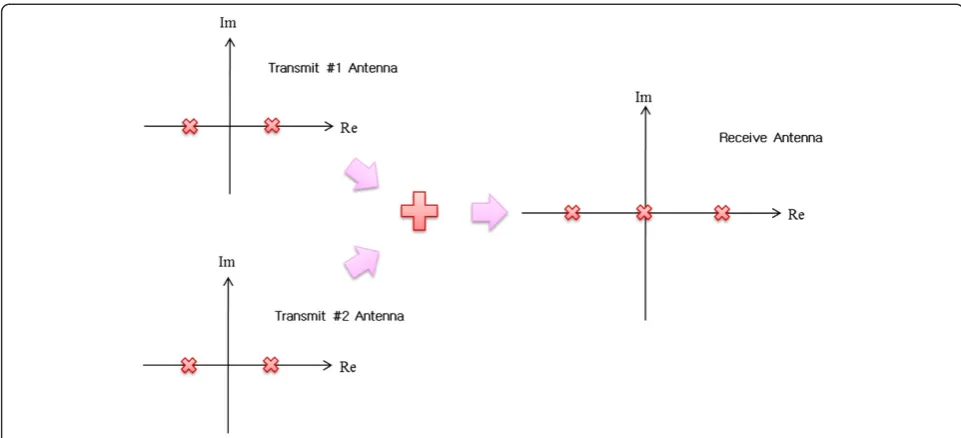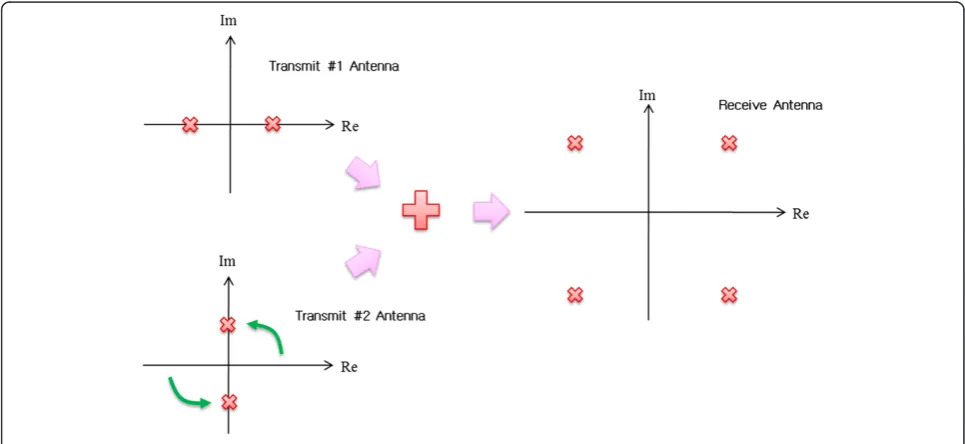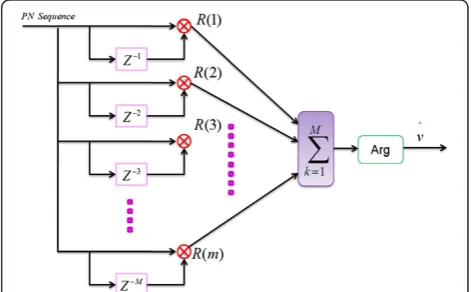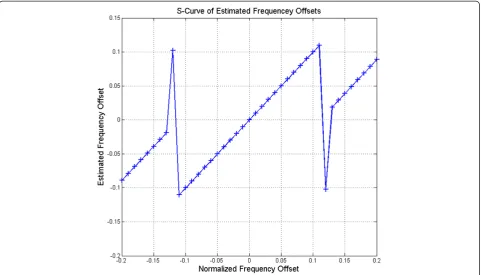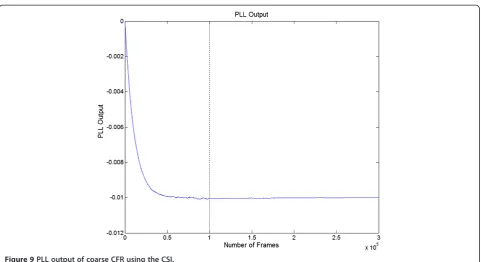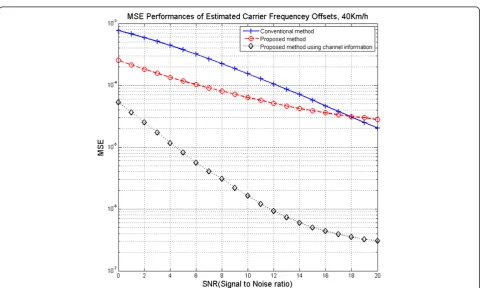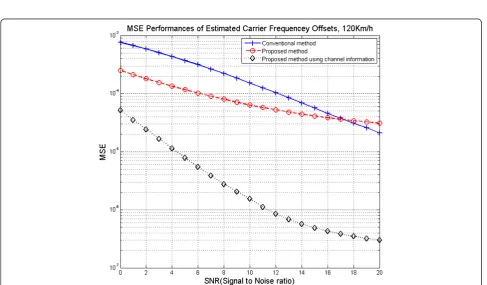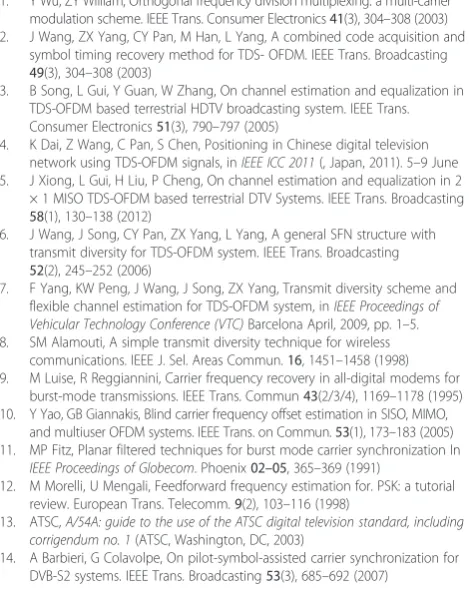R E S E A R C H
Open Access
Carrier frequency offset estimation method for
2 × 1 MISO TDS-OFDM systems
Jong Gyu Oh
1, Jun Heo
2and Joon Tae Kim
1*Abstract
In time-domain synchronous (TDS)-orthogonal frequency division multiplexing (OFDM) systems, a pseudo noise (PN) sequence is inserted instead of the cyclic prefix. The PN sequence is used not only as a guard interval but also as a training sequence for channel estimation and synchronization in the time domain. Recently, research studies on 2 × 1 multi input-single output (MISO) TDS-OFDM systems have been conducted, and different PN sequences (which are orthogonal to one another or cyclically shifted) are transmitted at each transmit antenna for channel estimation, which are modulated by binary phase shift keying in the same phase angle. However, when the absolute phase difference among the transmitted PN sequences is π, a PN sequence cancellation problem occurs, making the estimation of an accurate carrier frequency offset (CFO) difficult. In this paper, a CFO estimation method with the aid of PN sequences for 2 × 1 MISO TDS-OFDM systems is proposed. In the proposed method, the phase of the PN sequences at each antenna is rotated differently and transmitted to prevent a PN sequence-canceling problem. In addition, a CFO estimation scheme using channel state information is proposed to estimate an accurate CFO in time-varying channels. We show by computer simulations that the mean square error performance of the proposed method over an additive white Gaussian noise environment and time-varying Rayleigh channel is higher than that of the conventional method.
Keywords: TDS-OFDM; MISO; Carrier frequency offset estimation; PN sequence
1 Introduction
Orthogonal frequency division multiplexing (OFDM) systems [1] are popular broadband communication systems and have been well known to be effective against multipath distortion. In general OFDM sys-tems, cyclic prefix (CP) is inserted as a guard interval to efficiently combat multipath channel, and a pilot signal is inserted into the subcarriers for channel esti-mation and carrier recovery. In time-domain syn-chronous (TDS)-OFDM systems, a pseudo noise (PN) sequence is employed instead of the CP, which is modulated by binary phase shift keying (BPSK) [2]. The PN sequence is used not only as a guard interval but also as a training sequence for channel estimation and synchronization in the time domain [3]. Thus, it is not needed in the transmission of the pilot signal
among subcarriers, and the spectral efficiency of the TDS-OFDM systems is higher than that of the CP-OFDM systems. Currently, digital TV broadcasting services in China employ TDS-OFDM systems [4].
Recently, research on the transmit diversity scheme of the TDS-OFDM systems has been conducted in [5-7], and it mainly focused on the 2 × 1 multi input-single output (MISO) systems to achieve diver-sity gain. The Alamouti code [8] is a well-known transmission method for 2 × 1 MISO systems and can achieve good spatial diversity gain with minimal decoding complexity. Thus, 2 × 1 MISO TDS-OFDM systems are promising and reliable systems to achieve better performance. In these systems, different PN se-quences (which are orthogonal to one another or cyc-lically shifted) are transmitted at each transmit antenna for channel estimation, which are modulated by BPSK in the same phase angle. However, when the absolute phase difference among the transmitted PN sequences (which are transmitted in the same phase
* Correspondence:jtkim@konkuk.ac.kr 1
Department of Electronic Engineering, Konkuk University, Seoul, Republic of Korea
Full list of author information is available at the end of the article
type of a maximum likelihood (ML) method with several numbers of auto-correlators. In addition, a CFO estimation scheme using channel state informa-tion (CSI) is proposed to estimate an accurate CFO in time-varying channels. Using computer simula-tions, the mean square error (MSE) performance is measured by employing the proposed transmission method and the L&R algorithm over an additive white Gaussian noise (AWGN) environment and a time-varying Rayleigh channel. The rest of this paper is organized as follows: in Section 2, the PN cancellation problem is analyzed when the transmit-ted PN sequences have the same phase angle, and the CFO estimation method is introduced even under the presence of the PN cancellation problem; in Section 3, the CFO estimation method and a scheme that uses the CSI are proposed; the com-puter simulation results of the MSE performance are presented in Section 4; and conclusions are drawn in Section 5.
2 PN cancellation problem and CFO estimation method in conventional 2 × 1 MISO TDS-OFDM systems
2.1 System model
Let us consider a 2 × 1 MISO TDS-OFDM system with two transmit antennas, one receive antenna and Ndata subcarriers. The frame structure consists of the NPN (long PN sequence as the guard interval) and N subcarriers, as shown in Figure 1 [2,3]. At each transmit antenna, the PN sequences, which are orthogonal to one another or cyclically shifted, are transmitted by BPSK modulation in the same phase angle for MISO channel estimation [5-7]. We assume that the Doppler shifts be-tween all transmit-receive antenna pairs are approxi-mately the same [10]. quences from the first and second transmit antennas, re-spectively, ƒc is the CFO,Ts is the sampling period,θ is an unknown phase offset, andn(k) is the AWGN at the receive antenna.
2.2 Transmitted PN sequence cancellation problem and CFO estimation method
When two PN sequences are transmitted in the same phase angle in the conventional system [5-7], as shown in Figure 2, the receivedkth PN sequencePNTx(k) in the ideal channel state can be written as
PNTxð Þ ¼k (2b), the PN sequence cancellation problem occurs and PNTx(k) is equal to zero when the absolute phase difference between PN1(k) and PN2(k) is π, as expressed in (2c). To estimate the CFO, the modula-tion is first removed by multiplying the complex con-jugate of the locally generated PNTx(k) to receive the
arg½z kð Þzðk−1Þ ¼
arg 16 ejð2πfckTsþθÞþn0ð Þk e−jð2πfcðk−1ÞTsþθÞþn0ðk−1Þ
¼ arg 16 ej2πfcTsþn00¼2πf
cTsþn000 ;z kð Þ ¼z kð −1Þ ¼4e
jð2πfckTsþθÞ
n000
;otherwise
;
8 < :
ð4Þ
Figure 3CFO estimation method using transmitted PN sequences that have the same phase. (a,d)Normal CFO estimation condition.(b, d)Impossible CFO estimation condition.
Figure 2Received PN sequence when transmit PN sequences have the same phase.
where * is the complex conjugate operator and
n0
k
ð Þ ¼n kð ÞPN
Txð Þk :
The training-sequence-based method estimates the CFO using the phase difference among successive
training sequences. Thus, the phase difference betweenz (k) andz(k−1) can be obtained as follows:
where n00 ¼ej½2πfckTsþθn0ðk−1Þ þe−j½2πfcðk−1ÞTsþθn0ð Þk
þn0
k ð Þn0
k−1
ð Þandn' ' '= arg[n' '].
When (3a) exists continuously (meaning that (2a) and (2b2b) exist continuously), the CFO can be normally es-timated. These examples are shown in Figure 3.
Only when (2a) and (2b) exist continuously, as shown in Figure 3a,d, can the CFO be estimated normally. However, when (2c) exists, as shown in Figure 3b,c, the
phase difference between successive PN symbols cannot be used for the CFO estimation. Therefore, all the PN symbols may not be used for the CFO estimation, and the CFO cannot be estimated accurately using more than one auto-correlators, similar to that in the data-aided (DA)-ML methods [9,11,12].
and CFO estimation method in 2 × 1 MISO TDS-OFDM systems
In this section, the CFO estimation method is proposed, which rotates each phase of the transmitted PN se-quences and employs the L& R method in Section 3.1. Furthermore, a CFO estimation scheme that uses the CSI is proposed in Section 3.2 for accurate estimation in the Rayleigh channel.
3.1 Phase rotated PN transmission method and CFO estimation method employing L&R algorithm
In this section, a transmission method that rotates each phase of the transmitted PN sequences to prevent the PN sequence cancellation problem is proposed. In addition, a CFO estimation method employing the L&R algorithm [9] is proposed.
The proposed transmission method is explained as fol-lows: when the number of transmission is two, the phase of PN2(k) is rotated to make the phase difference betweenPN1(A) and PN2(k) beπ/2 for transmission, as shown in Figure 4. When the proposed method is
PNTxð Þ ¼k
When the phase of the transmitted PN sequences is rotated by the proposed method, thePNTx(k) sequences for all cases can be used for the CFO estimation, as shown in Figure 5a. In addition, more than one auto-correlators can be used for the CFO estimation, similar to the ML methods [9,11,12], because all consecutive
PNTx(k) sequences can be used, as shown in Figure 5b. Therefore, the accuracy of the estimated CFO can be in-creased as compared with that of the conventional method.
The frequency offset estimation method is explained as follows: the modulation is removed by multiplying the complex conjugate of the locally generated PNTx(k) to receiveyPN(k).
zPNð Þ ¼k yPNð ÞPNk Txð Þ ¼k ejð2πfckTsþθÞþn
0
k ð Þ; ð7Þ
wheren′ð Þ ¼k n kð ÞPNTxð Þk :
After removing the modulation of the received yPN(k), the phase difference is calculated from the argument of the multiplication betweenzPN(k) andZPNðK−1Þ: such noise, multiple auto-correlators are employed for CFO estimation in the L&R algorithm. R(m), which is the auto-correlation function ofzPN(k), can be written as
R mð Þ ¼N1
where Np is the number of PN sequences. Finally, the CFO can be estimated as
^v¼π N 1
whereNRis the number of auto-correlators. The accur-acy of the estimated CFO increases while the CFO esti-mation range decreases asNRincreases [9]. In addition, as NR increases, the number of R(m) in Figure 6 in-creases, and the hardware complexity increases.
Figure 7 shows the normalized CFO estimation range of the proposed method, and the NR value of the L&R method is equal to eight. When NR is set to eight, the
normalized CFO estimation range is from −0.11 to +0.11, as shown in Figure 7. This estimation range is sufficient in general terrestrial digital TV broadcasting environment [13]. If a wider estimation range is re-quired,NRcan be decreased or the M&M method [12], which shows an almost full estimation range, can be employed.
3.2 Frequency offset estimation scheme using CSI
The received kth PN sequence yPN(k) at the receive an-tenna in the time-varying Rayleigh channel can be writ-ten as
yPNð Þ ¼k ½h11PN1ð Þ þk h12PN2ð Þk ejð2πfc⋅iTsþθÞ þn kð Þ
¼PNTxð Þek jð2πfc⋅iTsþθÞþn kð Þ; ð11Þ
where h11 is the channel impulse response (CIR) from the first transmit antenna to the receive antenna andh12 is the CIR from the second transmit antenna to the re-ceive antenna. In the Rayleigh channel, h11 andh12 are
Figure 6L&R CFO estimation algorithm.
time varying, and the variation rate depends on the Dop-pler frequency.
The proposed PN sequence transmission method ro-tates the phase of the PN sequences to prevent the PN sequence cancellation problem. However, when the ab-solute phase difference between the time-varying h11 and h12 is π/2, the PN sequence cancellation problem occurs again, and the accuracy of the estimated CFO de-creases in contrast to that in the AWGN channel. In
other words, as the absolute phase difference between
h11andh12tends closer to π/2, the accuracy of the esti-mated CFO decreases; when it becomes smaller than π/ 2, the accuracy increases. Thus, the frequency offset estimation scheme using CSI is proposed, as shown in Figure 8.
The proposed scheme consists of the coarse carrier frequency recovery (CFR), which is a feedback structure, fine CFR, which is a feedforward structure, and phase
Figure 7Normalized frequency offset estimation range of proposed method.
calculator that uses CSI. For the estimation scheme, the proposed PN sequence rotation and the CFO estimation method are employed for the coarse CFR, and the pilot block correlation method in [14] can be employed for the fine CFO estimation algorithm. In the proposed scheme, the fine CFR estimates the CFO and applies it to the compensator using the PN sequence at every frame. On the other hand, the coarse CFR first estimates the CFO at every frame and applies it to the compensa-tor using the CSI. The phase estimacompensa-tor estimates the CSI using PN sequences over one PN block (guard interval) after the CFR and applies the estimated CFO to the phase locked loop (PLL) only when the absolute phase difference betweenh11andh12is smaller thanπ/4. If the absolute phase difference betweenh11 andh12is greater thanπ/4, zero is applied to the PLL.
However, the CSI may not be acquired until CFR is roughly achieved. Thus, the proposed scheme controls the PLL using the CSI only when a rough CFR is achieved.
Figure 9 shows the PLL output of a coarse CFR. CSI is not used for the CFR when the variance in the PLL output is smaller than 10−4or 100,000 frames are used for the CFR (dotted line). After 100,000 frames are used, the CSI is used for the phase difference calculation. In Figure 9, the PLL converges roughly without using the CSI, and rough CFR can be achieved without using the CSI. In addition, a fine CFO can be recovered after a coarse CFR; we can therefore decide whether to apply an estimated CFO to the PLL with the aid of the CSI after the PLL has roughly converged.
The PN cancellation problem in the conventional method can also be solved by employing the proposed frequency estimation scheme. For the conventional sys-tem, if the absolute phase difference betweenh11andh12 over one block is greater thanπ/4, the CFO is estimated by employing several auto-correlators and applying them to the PLL. However, the proposed PN sequence trans-mission method that uses the proposed scheme is suit-able for both the AWGN and time-varying Rayleigh channels, whereas the conventional method that uses the proposed scheme only works well in the time-varying channel.
4 Computer simulation results
The MSE performance is measured by applying the pro-posed PN transmission method and the L&R algorithm over the AWGN and Rayleigh channels. Ideal symbol timing recovery and frame detection situations are as-sumed, and the simulation parameters are listed in Table 1. The symbol rate and the center frequency of
Figure 9PLL output of coarse CFR using the CSI.
Table 1 Computer simulation parameters
Parameter Value
Symbol rateƒs 10.76 MHz
Center frequencyƒc 476 MHz
Size of PN sequence 201
Size of data symbol 3,780
Carrier frequency offset 1% of symbol rate
Maximum Doppler frequency 17.64 Hz (40 Km/h), 35.28 Hz (80 Km/h), 52.93 Hz (120 Km/h)
Figure 10MSE performance in AWGN.
Figure 12MSE performance over Rayleigh channel when the receiver’s velocity is 80 km/h.
is perfectly estimated. In contrast to the performance over the AWGN environment, the more the signal-to -noise ratio becomes higher, the more the MSE of the conventional method becomes smaller as compared with that of the proposed method. Because some of the CFOs are estimated by employing the proposed PN transmis-sion method when the phase difference betweenh11and
h12is closer to π/2, the accuracy of the estimated CFOs is lower than that of the conventional method. However, the MSE performance is much higher than that of the conventional method when the proposed transmission method and scheme using CSI are employed. In addition, the performance, which depends on the receiver’s velocity, is almost the same and shows only a slight difference. Be-cause the CFO is estimated using the phase difference of the consecutive PN sequences for short duration or seven delayed PN sequences for maximum duration, the channel variation over the PN sequences is not very high.
5 Conclusions
In this paper, we have proposed a PN sequence phase ro-tation transmission method and a frequency estimation scheme using CSI. The proposed PN transmission method rotated the transmitted PN sequences differently from one another to prevent the PN sequence cancellation problem and made possible the use of all consecutive PN sequences for the CFO estimation. In addition, the CFO was accur-ately estimated by the L&R algorithm, which is a type of DA-ML algorithm with multiple auto-correlators. For the time-varying Rayleigh channel, the frequency estimation scheme using the CSI has also been proposed. The simu-lation results show that the MSE performance of the pro-posed transmission method and estimation scheme over the AWGN and Rayleigh channels is higher than that of the conventional method.
Competing interests
The authors declare that they have no competing interests.
Authors’contributions
The work presented here was carried out in collaboration with all the authors. JGO, JH and JTK defined the research theme. JGO designed methods and experiments, carried out the laboratory experiments, analyzed the data, interpreted the results and wrote the paper. JH and JTK co-designed the dispersal and colonization experiments and co-worked on
References
1. Y Wu, ZY William, Orthogonal frequency division multiplexing: a multi-carrier modulation scheme. IEEE Trans. Consumer Electronics41(3), 304–308 (2003) 2. J Wang, ZX Yang, CY Pan, M Han, L Yang, A combined code acquisition and
symbol timing recovery method for TDS- OFDM. IEEE Trans. Broadcasting
49(3), 304–308 (2003)
3. B Song, L Gui, Y Guan, W Zhang, On channel estimation and equalization in TDS-OFDM based terrestrial HDTV broadcasting system. IEEE Trans. Consumer Electronics51(3), 790–797 (2005)
4. K Dai, Z Wang, C Pan, S Chen, Positioning in Chinese digital television network using TDS-OFDM signals, inIEEE ICC 2011(, Japan, 2011). 5–9 June 5. J Xiong, L Gui, H Liu, P Cheng, On channel estimation and equalization in 2
× 1 MISO TDS-OFDM based terrestrial DTV Systems. IEEE Trans. Broadcasting
58(1), 130–138 (2012)
6. J Wang, J Song, CY Pan, ZX Yang, L Yang, A general SFN structure with transmit diversity for TDS-OFDM system. IEEE Trans. Broadcasting
52(2), 245–252 (2006)
7. F Yang, KW Peng, J Wang, J Song, ZX Yang, Transmit diversity scheme and flexible channel estimation for TDS-OFDM system, inIEEE Proceedings of Vehicular Technology Conference (VTC)Barcelona April, 2009, pp. 1–5. 8. SM Alamouti, A simple transmit diversity technique for wireless
communications. IEEE J. Sel. Areas Commun.16, 1451–1458 (1998) 9. M Luise, R Reggiannini, Carrier frequency recovery in all-digital modems for
burst-mode transmissions. IEEE Trans. Commun43(2/3/4), 1169–1178 (1995) 10. Y Yao, GB Giannakis, Blind carrier frequency offset estimation in SISO, MIMO,
and multiuser OFDM systems. IEEE Trans. on Commun.53(1), 173–183 (2005) 11. MP Fitz, Planar filtered techniques for burst mode carrier synchronization In
IEEE Proceedings of Globecom. Phoenix02–05, 365–369 (1991)
12. M Morelli, U Mengali, Feedforward frequency estimation for. PSK: a tutorial review. European Trans. Telecomm.9(2), 103–116 (1998)
13. ATSC,A/54A: guide to the use of the ATSC digital television standard, including corrigendum no. 1(ATSC, Washington, DC, 2003)
14. A Barbieri, G Colavolpe, On pilot-symbol-assisted carrier synchronization for DVB-S2 systems. IEEE Trans. Broadcasting53(3), 685–692 (2007)
doi:10.1186/1687-1499-2013-217
Cite this article as:Ohet al.:Carrier frequency offset estimation method for 2 × 1 MISO TDS-OFDM systems.EURASIP Journal on Wireless Communications and Networking20132013:217.
Submit your manuscript to a
journal and benefi t from:
7Convenient online submission 7Rigorous peer review
7Immediate publication on acceptance 7Open access: articles freely available online 7High visibility within the fi eld
7Retaining the copyright to your article

